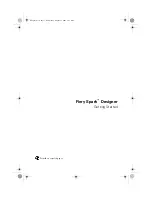
Color: The Perceived World
251
❚❘❘
As this table suggests, most nonmetals have rela-
tively low reflectance, but even soot has a reflectance
greater than 0. Metals have higher reflectance, but
even they are well below 1. Most environments
contain very little highly polished silver.
Setting Reflectance in Lightscape
Proper choice of reflectance is very important for
creating realistic images.
If the reflectance is too high, the environment
appears flat because shadows and shading get
washed out by the large quantities of indirect illumi-
nation. In addition, it takes a long time for the
radiosity solution to distribute most of the unshot
energy.
If the reflectance is too low, there is insufficient indi-
rect illumination and the environment becomes too
dark in regions that are not directly illuminated. You
can use the previous table to help define the reflec-
tance of material, as discussed in Chapter 7, “Using
Materials.”
Light in Computer Graphics
Because computer graphics models the interactions
of light with surfaces, it needs to represent these
spectra. This can be difficult, for several reasons:
•
A good representation increases the time and
memory needed to create an image.
•
Very little information is available on the spectral
reflectance of surfaces and lights; no industry stan-
dard formats exist.
•
Specifying materials and lights by specifying the
spectral curves is not an intuitive process.
For these reasons, computer graphics applications
usually approximate spectra using three wave-
lengths of light—one each of red, green, and blue.
These three wavelengths are often based on the red,
green, and blue values displayed on the screen. In
many cases this is not a serious limitation, although
it makes it impossible to accurately compute solu-
tions for environments where the exact spectral
information is known.
Color: The Perceived World
When light with a particular spectrum enters the
eye, it is perceived as a color. This process is very
complex and much of it is not well understood. The
physiology of the eye determines how the light is
transformed into a signal to the brain. Inside the
brain, more complicated and less understood
perceptual transformations take place that help us to
understand the images we see. This section
describes how color is perceived by the human eye,
how it is reproduced, and how it is computed.
The Eye
Within the retina (back of the eye) there are two
types of light-sensitive cells, rods and cones. Every
retina has approximately three million cones and
one hundred million rods. Rods discern light and
dark, shape, and movement, and contain only one
light-sensitive pigment. Cones, which need more
light than rods to work, come in three varieties, each
of which respond to a different light wavelength—
green, red, or blue. The combination of these three
wavelengths permits color discrimination.
Because of how cones work, the eye can describe a
color response without describing the entire spec-
trum of the light striking the retina. Thus, color can
be represented with three values—red, green, and
blue.
Summary of Contents for LIGHTSCAPE
Page 1: ...SULO 4 31 93 36034333308355 LJKWVFDSH...
Page 18: ...NOTES 10...
Page 110: ...NOTES 102...
Page 136: ...NOTES 128...
Page 166: ...NOTES 158...
Page 176: ...NOTES 168...
Page 202: ...NOTES 194...
Page 210: ...NOTES 202...
Page 248: ...NOTES 240...
Page 294: ...NOTES 286...
Page 308: ...NOTES 300...
Page 316: ...NOTES 308...
Page 324: ...NOTES 316...
Page 342: ...Glossary 334 Lightscape...
Page 360: ...Index ix 352 Lightscape...
Page 362: ......
















































